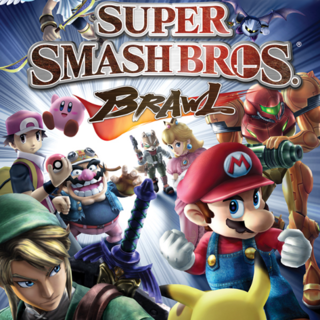This game for the Nintendo Wii system is just amazing. The 2-D gameplay features are by far out better than the original
With more than six million copies sold worldwide since its release seven years ago, Super Smash Bros. Melee remains – easily -- GameCube's best-selling title. The 3D fighter, a sequel to 1999's surprise hit Nintendo 64 project Super Smash Bros., packed in more characters, more stages and a seemingly endless supply of nostalgic trophies and collectibles to become one of the system's most beloved efforts. There was so much content squeezed into Melee, in fact, that the multiplayer fighter kept devoted fans entertained not just for months, but years. Yet, compared to the Whopper that is Super Smash Bros Brawl, a Wii game dripping with different play modes, characters, stages and online components, Melee has been reduced to a plain old hamburger. (And by the way, we're hungry.)
Hungry, that is, for some epic offline and online multiplayer fights, and thankfully Brawl – like its predecessors – satisfies. If you want numbers, we've got them. Nintendo's latest fighter features 35 mascots – a figure up from 12 in the original and 26 in Melee. It also includes more than 40 different levels, each a throwback to classic franchise stages, both from Nintendo and also from the likes of SEGA and Konami, but we'll get to that. Point is, it's a much meatier package -- we honestly don't know why we can't seem to break from our hamburger analogies – and we haven't even started in on the customization options, online support, and more.
With Brawl, famed series director Masahiro Sakurai and his Sora development team have spared no expense to bring to life the full Smash Bros. universe with a meticulous attention to detail and a decidedly un-Nintendo approach to presentation. For example, whereas the Big N chose not to spring for orchestrated music for The Legend of Zelda: Twilight Princess, one of the company's biggest titles, Sakurai has enlisted the aid of the industry's greatest musicians to record a largely orchestrated soundtrack for his fighter. In what other game will you be able to listen to music from Masafumi Takada (of Killer 7 fame), Kenji Ito, Koji Kondo and Akihiro Honda (who recently helped score Metal Gear Solid 4)? There are nearly 40 musicians providing songs to what is one of the greatest Nintendo soundtracks available.
Meanwhile, if you're a longtime Nintendo fan, you will be amazed by the presentation of the story sequences in Brawl's unnecessary, but nevertheless lengthy (eight-plus hours) single-player mode, known as the Subspace Emissary. Crisp, colorful full-motion animation sequences tell the story of a ridiculously epic battle between dozens of Mushroom Kingdom characters. It's clear from the opening cinematic that the studio has put a lot of time and thought into crafting the action-packed snippets, which successfully bridge the gap between the traditional platformer-esque challenges comprising the single-player affair. The storyline itself seems almost randomly compiled – a pieced together jigsaw puzzle of different factions coming together. Only after you advance halfway through are you likely to grasp the tale's underlying purpose, but at least it looks and sounds great along the way.
Mario and Sonic face off in Brawl
Brawl looks like an enhanced version of Melee. The title runs in both 480p and 16:9 widescreen display for the first time, and it also hums along at an uninterrupted 60 frames per second. This is true despite the fact that the in-world characters are comprised of more polygons and skinned with more detailed textures, likewise for the many environments (some of which are destructible), and that the title features some of the most beautiful particle explosions in any Nintendo entry yet. It's certainly a good looking Wii game, and yet many of the backgrounds are kept very simple in an effort to the keep the framerate up and character animations, while speedy, typically ignore the laws of physics, weight, and momentum. These minor nitpicks will be tossed to the side, however, the moment you're engaged in an intense four-player battle overrun with explosions and background destruction, all without so much as a hiccup in fluidity.
That said, there are some presentational deficiencies, too, although these shortcomings aren't nearly as blatant as the fighter's many qualities. The cartridge-fast speed in which you can navigate Brawl's character and stage selection screens is marred by a 20-second front-end load, a truth that clashes with the majority of other Nintendo-published titles. Meanwhile, the Subspace Emissary's flow is broken by similarly too-long loads between in-game progress and the animation sequences that complement them.

